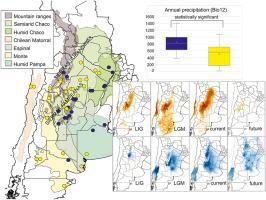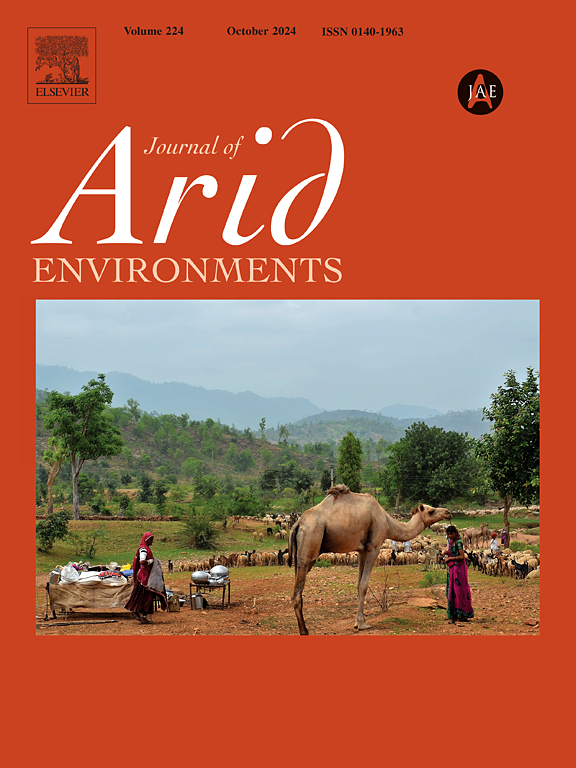Intraspecific genetic diversity matters: Genetic lineages of Solanum elaeagnifolium show contrasting responses to climate change across time
IF 2.5
3区 环境科学与生态学
Q2 ECOLOGY
引用次数: 0
Abstract
Semiarid environments dominate southern South America. These regions are highly vulnerable to climate change and prone to undergo the consequent shifts in species distribution. Solanum elaeagnifolium is common in the Chaco and Monte ecoregions, where two distinct genetic lineages have been identified. This study aimed to determine whether these lineages are associated with different climatic conditions, to characterize their climatic niches, and to analyze their responses to past and future climate change. We used phylogeographic and ecological approaches. Individuals of S. elaeagnifolium were sequenced to determine their lineage; subsequently, we analyzed the bioclimatic envelope of each lineage and developed ecological niche models (ENMs) to reconstruct their current, historical, and potential future distributions, as well as to define their niches. One lineage, referred to as the yellow lineage, predominates in the lowland Dry Chaco and Monte ecoregions, while the other, hereafter the blue lineage, is more common in the Humid Chaco and in the Sierras Pampeanas within the Dry Chaco, likely reflecting differences in precipitation requirements. Niche comparisons between S. elaeagnifolium lineages showed that their niche overlap is likely due to chance. According to the ENM results, the yellow lineage has maintained a relatively stable distribution throughout glacial cycles, whereas the blue lineage shows more dynamic shifts. Future projections suggest a stable range for the blue lineage and a contraction for the yellow lineage. This study underscores the importance of considering intraspecific genetic and ecological variability to understand a species’ evolutionary history and ecological preferences, with implications for management and conservation.

种内遗传多样性的问题:龙葵的遗传谱系显示不同时间对气候变化的不同反应
南美洲南部主要是半干旱环境。这些地区极易受到气候变化的影响,因此容易发生物种分布的变化。龙葵在查科和蒙特地区很常见,在那里已经确定了两个不同的遗传谱系。本研究旨在确定这些谱系是否与不同的气候条件有关,表征它们的气候生态位,并分析它们对过去和未来气候变化的响应。我们使用了系统地理学和生态学方法。对三叶草进行了遗传序列测定;随后,我们分析了每个谱系的生物气候包络,并建立了生态位模型(ENMs)来重建它们的当前、历史和潜在的未来分布,并定义了它们的生态位。一个谱系,被称为黄色谱系,主要分布在低地的干查科和蒙特地区,而另一个谱系,以下称为蓝色谱系,在湿润查科和干查科内的山脉Pampeanas中更常见,可能反映了降水需求的差异。通过对竹叶系间生态位的比较,发现它们的生态位重叠可能是偶然的。根据ENM结果,黄色谱系在整个冰期循环中保持相对稳定的分布,而蓝色谱系则表现出更多的动态变化。未来的预测表明,蓝色谱系的范围稳定,黄色谱系的范围收缩。这项研究强调了考虑种内遗传和生态变异对了解物种进化史和生态偏好的重要性,对管理和保护具有重要意义。
本文章由计算机程序翻译,如有差异,请以英文原文为准。
求助全文
约1分钟内获得全文
求助全文
来源期刊

Journal of Arid Environments
环境科学-环境科学
CiteScore
5.70
自引率
3.70%
发文量
144
审稿时长
55 days
期刊介绍:
The Journal of Arid Environments is an international journal publishing original scientific and technical research articles on physical, biological and cultural aspects of arid, semi-arid, and desert environments. As a forum of multi-disciplinary and interdisciplinary dialogue it addresses research on all aspects of arid environments and their past, present and future use.
 求助内容:
求助内容: 应助结果提醒方式:
应助结果提醒方式:


